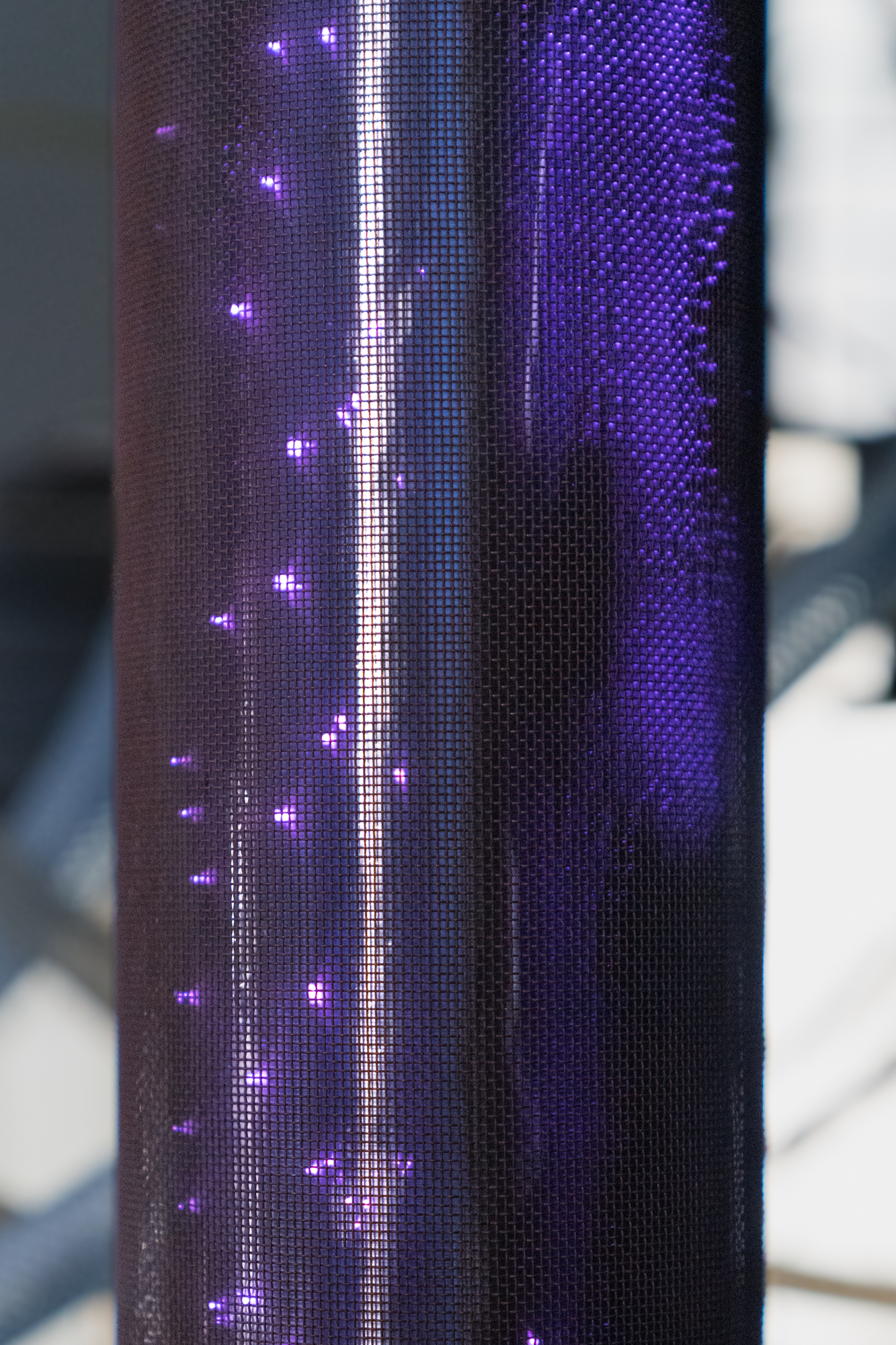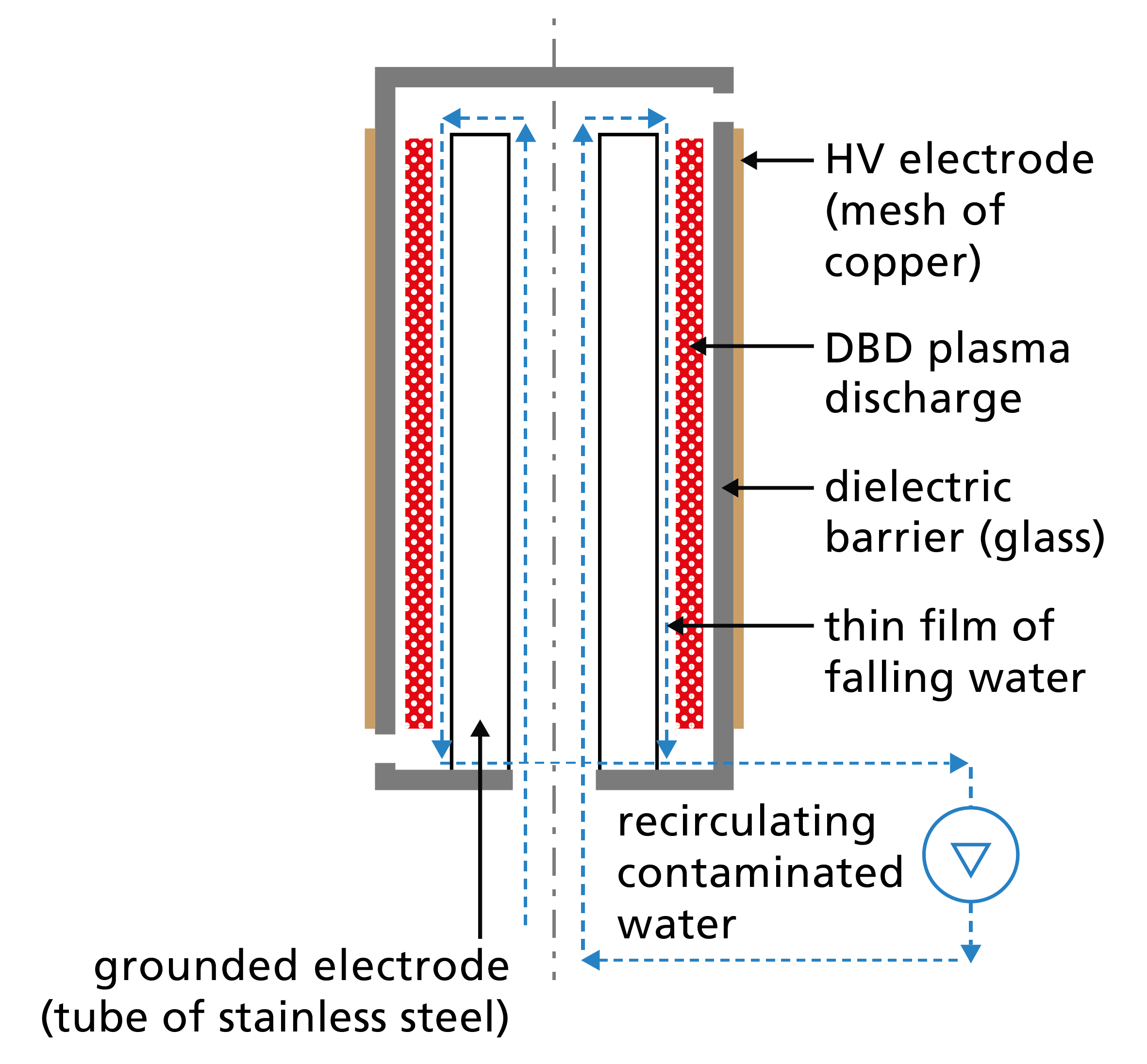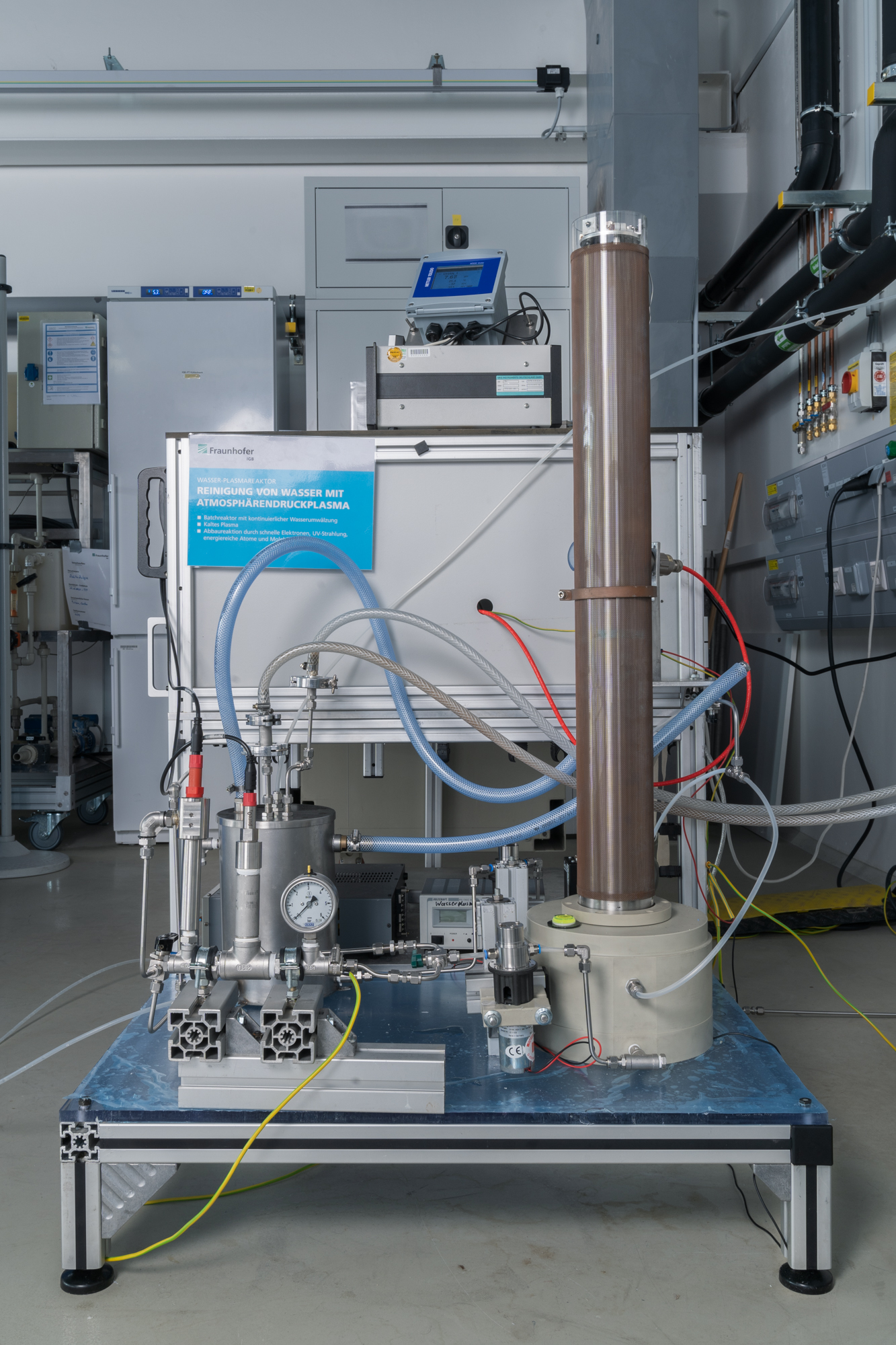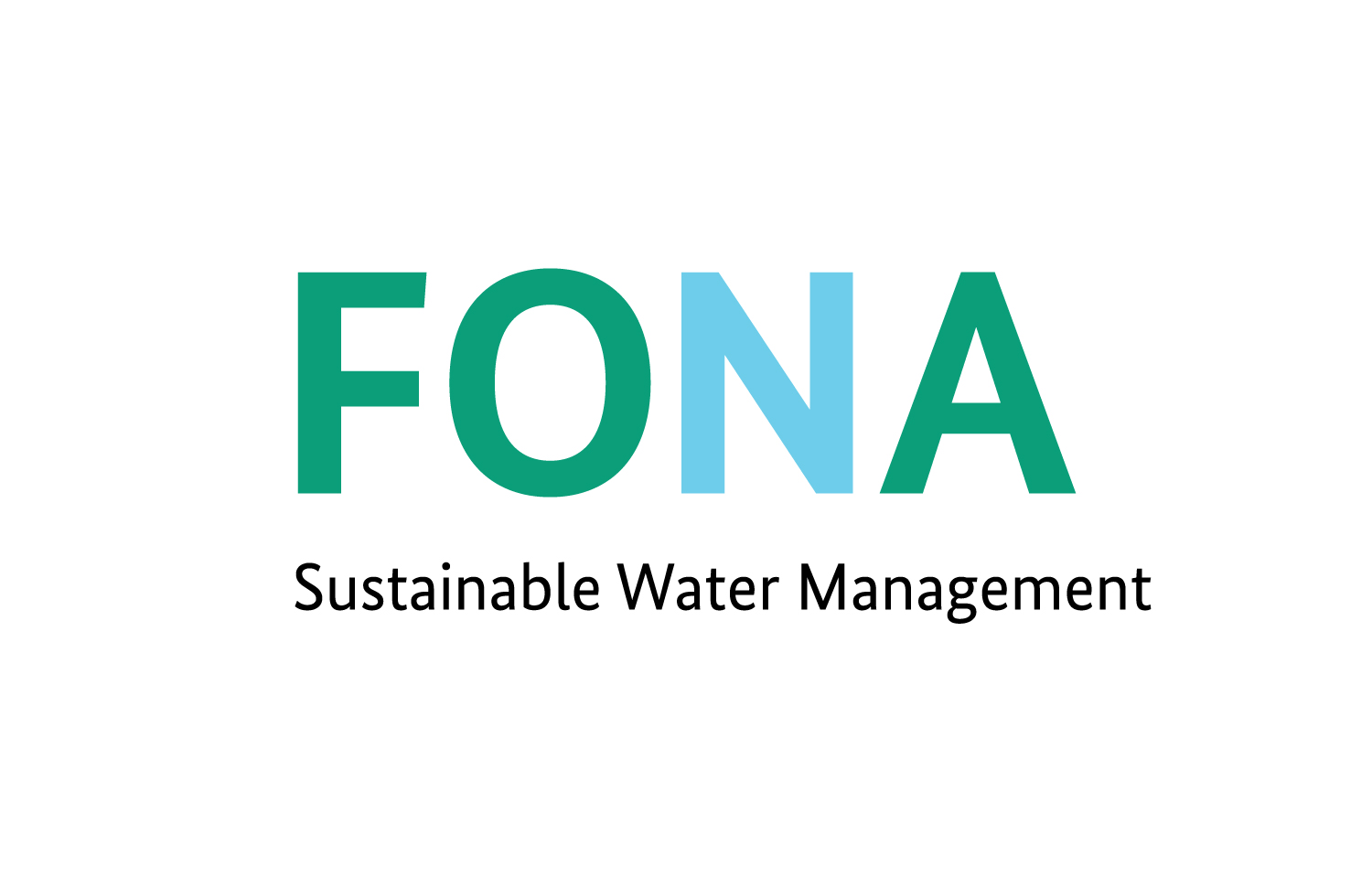Wastewater treatment
Plasma against toxic PFAS chemicals
Harmful PFAS chemicals can now be detected in many soils and bodies of water. Removing them using conventional filter techniques is costly and almost infeasible. Researchers at the Fraunhofer Institute for Interfacial Engineering and Biotechnology IGB are now successfully implementing a plasma-based technology in the AtWaPlas joint research project. Contaminated water is fed into a combined glass and stainless steel cylinder where it is then treated with ionized gas, i.e. plasma. This reduces the PFAS molecular chains, allowing the toxic substance to be removed at a low cost.



Per- and polyfluoroalkyl substances (PFAS) have many special properties. As they are thermally and chemically stable as well as resistant to water, grease and dirt, they can be found in a large number of everyday products: Pizza boxes and baking paper are coated with them, for example, and shampoos and creams also contain PFAS. In industry they serve as extinguishing and wetting agents, and in agriculture they are used in plant protection products. However, traces of PFAS are now also being detected where they should not be found: in soil, rivers and groundwater, in food and in drinking water. This is how the harmful substances end up in the human body. Due to their chemical stability, eliminating these so-called “forever chemicals” has been almost impossible up to now without considerable effort and expense.
The AtWaPlas joint research project aims to change that. The acronym stands for Atmospheric Water Plasma Treatment. The innovative project is currently being run at the Fraunhofer Institute for Interfacial Engineering and Biotechnology IGB in Stuttgart in cooperation with the industrial partner HYDR.O. Geologen und Ingenieure GbR from Aachen. The aim is to treat and recover PFAS-contaminated water using plasma treatment.
The research team led by Dr. Georg Umlauf, an expert in functional surfaces and materials, utilizes plasma’s ability to attack the molecular chains of substances. The electrically conductive gas consisting of electrons and ions is generated when high voltage is applied. “Our experiments with plasma have been successful in shortening the PFAS molecule chains in water. This is a significant step towards efficiently removing these stubborn pollutants,” Umlauf is happy to report.
Water cycle in a stainless steel cylinder
Fraunhofer researchers are using a cylindrical construction for this plasma process. Inside is a stainless steel tube, which serves as the ground electrode of the electrical circuit. The outer copper mesh then acts as a high-voltage electrode and is protected on the inside by a glass dielectric. A very small gap is left between the two, which is filled with an air mixture. This air mixture is converted into plasma when a voltage of several kilovolts is applied. It is visible to the human eye by its characteristic glow and discharge as flashes of light.
During the purification process, the PFAS-contaminated water is introduced at the bottom of the stainless steel tank and pumped upwards. It then travels down through the gap between the electrodes, passing through the electrically active plasma atmosphere. The plasma breaks up and shortens the PFAS molecule chains as it discharges. The water is repeatedly pumped through both the steel reactor and the plasma discharge zone in a closed circuit, reducing the PFAS molecule chains further each time until they are completely mineralized. “Ideally, the harmful PFAS substances are eliminated to the point that they can no longer be detected in mass spectrometric measurements. This also complies with the strict German Drinking Water Ordinance (TrinkwV) regulations regarding PFAS concentrations,” says Umlauf.
The technology developed at the Fraunhofer Institute has a key advantage over conventional methods such as active carbon filtering: “Active carbon filters can bind the harmful substances, but they are unable to eliminate them. This means that the filters must be replaced and disposed of regularly. The AtWaPlas technology, on the other hand, is capable of completely eliminating the harmful substances without any residue and is very efficient and low-maintenance,” explains Fraunhofer expert Umlauf.
Real water samples instead of synthetic laboratory samples
In order to ensure true feasibility, the Fraunhofer researchers are testing the plasma purification under more challenging conditions. Conventional test methods involve using perfectly clean water and PFAS solutions that have been synthetically mixed in the laboratory. However, the research team in Stuttgart is using “real” water samples that come from PFAS-contaminated areas. The samples are collected by the project partner HYDR.O. Geologen und Ingenieure GbR from Aachen. The company specializes in cleaning up contaminated sites and also carries out hydrodynamic simulations.
The real water samples that Umlauf and his team work with therefore contain PFAS as well as other particles, suspended solids and organic turbidity. “This is how we verify the purification efficiency of AtWaPlas, not only using synthetic laboratory samples, but also under real conditions with changing water qualities. The process parameters can be adapted and further developed at the same time,” explains Umlauf.
This plasma method can also be used to break down other harmful substances, including pharmaceutical residues in wastewater, pesticides and herbicides, but also industrial chemicals such as cyanides. AtWaPlas can also be used to treat drinking water in mobile applications in an environmentally friendly and cost-effective way.
The AtWaPlas joint research project launched in JuIy 2021. After a successful series of pilot-scale tests with a 5 liter reactor, the Fraunhofer team is now working with the joint research partner to further optimize the process. Georg Umlauf states: “Our current objective is to completely eliminate toxic PFAS by extending process times and increasing the number of circulations in the tank. We also want to make the AtWaPlas technology available for practical application on a larger scale.” The future could see corresponding plants set up as standalone purification stages in sewage treatment plants or used in portable containers on contaminated open-air sites.
Funding
The German Federal Ministry of Education and Research (BMBF) is funding the "AtWaPlas" project within the "KMU-innovativ: Ressourceneffizienz und Klimaschutz" funding measure, promotional reference 02WQ1601B, as part of the federal research program on water “Wasser: N”. Wasser: N contributes to the BMBF “Research for Sustainability’ (FONA) Strategy”.



 Fraunhofer Institute for Interfacial Engineering and Biotechnology IGB
Fraunhofer Institute for Interfacial Engineering and Biotechnology IGB